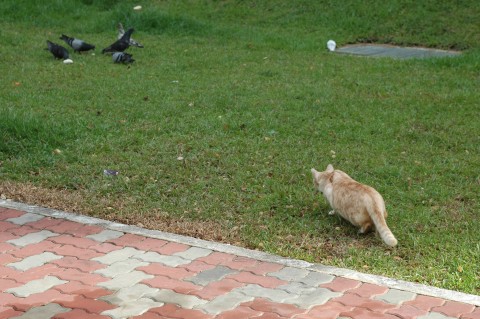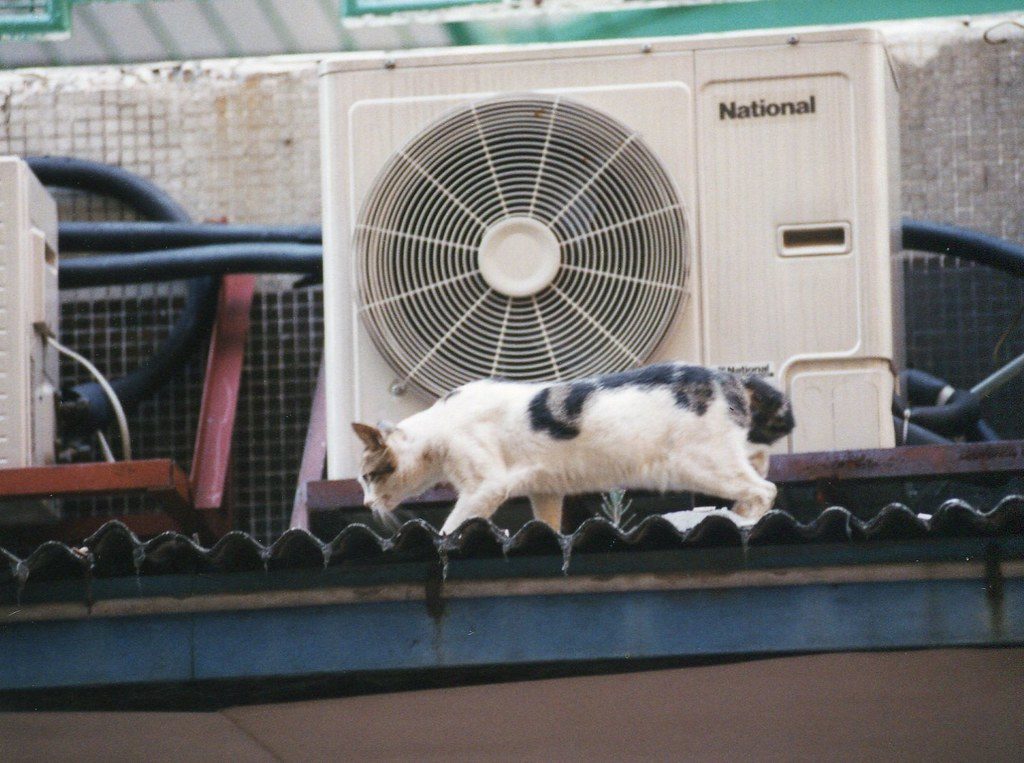Let’s begin by saying that housecats are not native to Australia, and they did not ask to come to the continent. It is thought they first entered the country at some point between the 17th and the 18th century, introduced by European settlers who used them to trap rats on board their ships. Their presence in Australia is therefore “man-made.” The number of cats has ballooned since those beginnings, with the total population now ranging between 2 to 6 million.
The Australian government considers feral cats to be a threat to biodiversity and an environmental catastrophe. Why?

A feral cat stalks pigeons. Feral cats can have a large negative effect on wild animal populations, especially birds and small rodents. Image credit Kim Bartlett – Animal People, Inc.
Feral cats roam freely in the wild, where they usually survive by hunting. They are blamed for threatening and decimating native animal populations.
In 2015, the Australian government announced its plan to cull the population of feral cats in the country in an effort to save threatened and endangered native species.
The “Threatened Species Strategy” released by the Australian government in 2015 stated that: “The scientific evidence is unequivocal that feral cats are one of the greatest threats to Australia’s land-based mammals. They have been a major contributor to the extinction of at least 27 mammals since they were first introduced to Australia. Today, they imperil at least 142 species or more than one third of our threatened mammals, reptiles, frogs and birds.” With this document, Australia’s war on cats was declared.
The document identifies a set of actions, among which are the development and deployment of Curiosity, the new humane feral cat bait; support for the establishment of feral cat free areas; and scaling up cat eradication.
The first target to measure the success of the action plan is two million feral cats culled by 2020. Yes, you read that right. Australian authorities hope to kill two million feral cats by 2020.
The government policy to save the wild animals that define Australia as a nation is resulting in a mass feral cat cull, a true slaughter.
However, officials should understand that merely killing cats does not necessarily protect biodiversity. A more holistic approach is needed. The government is focusing heavily on damage caused by feral cats, but at the same time ignoring more important but politically sensitive issues, such as habitat loss caused by urban expansion, logging and mining.
Additionally, the cat population management strategy called trap neuter release (TNR), whereby cats are trapped, surgically sterilized, and released back where they were caught, has been proven repeatedly to be more effective and long-lasting than culling. TNR is a superior strategy, as it results in significantly reduced cat populations and is a humane option.

A feral cat walks on a rooftop in Hong Kong. Feral cat populations can balloon and have negative effects all over the world, and TNR is the best management strategy. Image credit Kim Bartlett – Animal People, Inc.
The plan to cull the population of feral cats, started in 2015 in an effort to save threatened and endangered native species, is recently becoming particularly shocking. Cats are now being tortured and killed with deadly food. Poison sausages are dropped from airplanes or tossed into areas with high concentrations of stray cats by hand.
Eradicat (the name of this poison bait) is a registered trademark of the Western Australian government and was invented by David Algar, a scientist nicknamed Doctor Death. The sausages are laced with 1080, that is sodium monofluoroacetate. This poison occurs naturally in gastrolobium pea plants and is also produced synthetically. The recipe also includes kangaroo meat, chicken fat, and flavorings to entice feral cats. Australia’s native animals evolved alongside these kind of peas and they are therefore tolerant to the poison. The same doesn’t apply to non-native animals, such as cats, for whom it is lethal.
In addition to poison bait, the government is using also other tools in its controversial mission to eradicate the feline population. Since the declaration of war on feral cats, the government has pledged five million dollars to support community groups who target cats on the front line.
As a consequence, trapping and shooting cats has become commonplace in Australia. In an area of Queensland, there is a council that offers a ten dollar bounty per feral cat scalp. In other areas, detector dogs are used to track down cats who are then shot.
Featured image: free-roaming cats in Nicosia, Cyprus. Image credit Wolf Gordon Clifton / Animal People, Inc.





